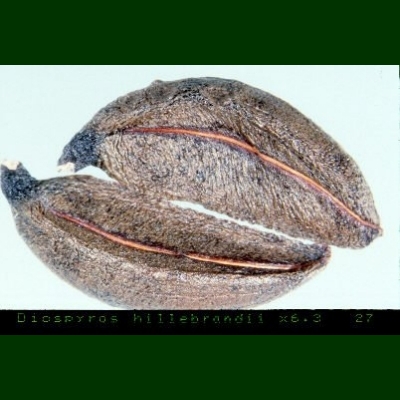 Hawaiian Name(s): lama, ēlama
Hawaiian Name(s): lama, ēlamaScientific Name: Diospyros (2 species)
Vernacular Name: persimmon, ebony
Family: Ebenaceae
Status: endemic
Authority: D. sandwicensis (A.DC.) Fosberg, D. hillebrandii (Seem.) Fosberg
Description: Trees 7-13 m tall, leaves thick, leathery and dull.
Habitat D. sandwicensis: dry to mesic to wet forest, 5–1220 m, D. hillbrandii 150-760 m, diverse mesic forest (Wagner et al. 1990:585–587).
Medicines: Lama is not a primary medicinal plant, but can be found as a secondary ingredient in many remedies. For cuts, boils, abcesses, bruises, and cold sores powdered lama is mixed with crushed ‘ahu‘awa (Cyperus javanicus) (Chun 1994:15). In the cleansing of puho and kaupo the bark of ‘ahakea (Bobea spp.), ‘āla‘a (Pouteria sandwicensis), and ‘auko‘i stalk (Senna occidentalis) are used, and then ‘ulu sap (Artocarpus altilis) with powdered ‘ahu‘awa and lama are placed on the affected area (Chun 1994:73). For "burns on the rear end" and puho puhi ka‘oka‘o lama ashes are combined with kawa‘u (Ilex anomala?) and ‘ahu‘awa as a salve (Chun 1994:142). For infected sores, including puho ‘a‘ai, the green flesh of the kukui fruit is cooked in kī leaves (ti, Cordyline fruticosa) and combined with ‘ulu sap, powdered ‘ahu‘awa, and powdered lama; the mixture is applied as a salve (Chun 1994:171). For palaki‘o (whitish flesh bumps) limu ‘ekaha (?) is mixed with ‘ulu sap and lama powder, and maybe he‘i (papaya, Carica papaya) as an ointment (Chun 1994:182). For ‘ea, pa‘ao‘ao, and pala o ka waha in children, dried limu lipoa kuahiwi (?moss) and lipoa kai (cf. Dictyopteris spp.) are mixed with powdered lama and milky sap from the kukui and ‘ulul fruits. To be placed on the affected parts (Chun 1994:190). For the illnesses palaki‘o, puho wai nui, puka puhi and cuts, ashes from limu ‘onohiawa (Chara zeylanica), kūkaepua‘a (Digitaria setigera), paka (tobacco, Nicotiana spp.) , and powdered lama are mixed with the milky sap of the he‘i and smeared on the affected parts (Chun 1994:194). For treatment of pu‘upu‘u nunui, kolekole ‘a‘ai, and puho, the ashes of ‘ohe (Schizostachyum glaucifolium) are mixed with dried powder of ‘ahu‘awa and lama, with the milky sap of he‘i and green kukui fruits and applied to the areas affected (Chun 1994:223). For ‘ea muhe‘e lehua and pa‘ao‘ao, a combination of red leaf buds of lehua hamau and lehua ‘apane (Metrosideros spp.), are fermented with the leaves, fruit, and leaf buds of the lama; it is then cooked, strained, and fed to children (Chun 1994: 227– 228). As a finish for treatments of cuts and abscesses ‘ahu‘awa and lama powders are spinkled (Chun 1994:234, 235).
Non Medicinal Uses: Hard wood used for god images, house posts, and house fences (Malo 1951:21), fences of mapele or unu o Lono (type of heiau) (Malo 1951:160, 189); fruits eaten (Hillebrande 1888:275; Krauss 1993:16). Lama is a sacred plant, and a uncarved block of wood placed on hula altar (kuahu) wrapped in yellow kapa (usually wauke, Broussonetia papyrifera, scented with ‘ōolena, Cucurma longa) to represent Laka (Mitchell 1982:51); sticks in fish traps (Krauss 1993:41), name means "light", and connotates "enlightenment" (Pukui and Elbert 1986:192). [All these uses seem most associated with D. sandwincensis]. In the Ethnology Collection at Bishop Museum there is a post-contact example of the wood made into a bowl.
Specific gravity of wood: unknown
Famous Locations:
Mele:
`Ōlelo Noeau:
Dye Color and Parts:
Kino lau:
Location on Bishop Museum Kalihi Campus:
Propagation Information: Intermediate. Fresh seeds covered with 1/4 in potting medium, water regularly; slow growing as time goes on; pot sprouts after 1st phase of root growth in a tall, well drained pot; needs careful nurture once planted in ground, needs certain mauka forest soils to thrive (Bornhorst 1996:66–67; Culliney and Koebele 1999:98–101).
Hawaiian Native Plant Propagation Database.
Native Plants Hawaii.
Seed: Seed length approximately 14 mm. Photograph: H.Lennstrom. Species: D. hillebrandii.

Microscopy
Cross Section: Field of view: 2.6 mm x 1.6 mm. Photograph: H.Lennstrom. Species: D. sandwicensis.

Radial Section: Field of view: 2.6 mm x 1.6 mm. Photograph: H.Lennstrom. Species: D. sandwicensis.

Tangential Section: Field of view: 2.6 mm x 1.6 mm. Photograph: H.Lennstrom. Species: D. sandwicensis.

